Foundation Skills in Data Analysis: Car Insurance Brokerage Report
VerifiedAdded on 2022/11/01
|8
|2385
|468
Report
AI Summary
This report presents a comprehensive analysis of car insurance brokerage services based on a sample of 400 customers. It addresses questions raised by Paul Anderson, examining customer savings, broker performance, satisfaction levels, and the relationship between insurance premiums and various factors. The analysis reveals key findings, including the median savings, performance comparisons between insurance brokers, drivers of customer satisfaction, and the impact of car value on insurance premiums. The report also estimates the range of mean savings for all customers, the proportion of customers worse off with brokers, and compares current savings with historical data. Furthermore, it assesses the claim about the proportion of males using broker services and determines the required sample size for future studies. The analysis concludes with a summary of the key findings and implications for car insurance brokerage services, offering a data-driven perspective on customer experiences and the effectiveness of brokerage services.
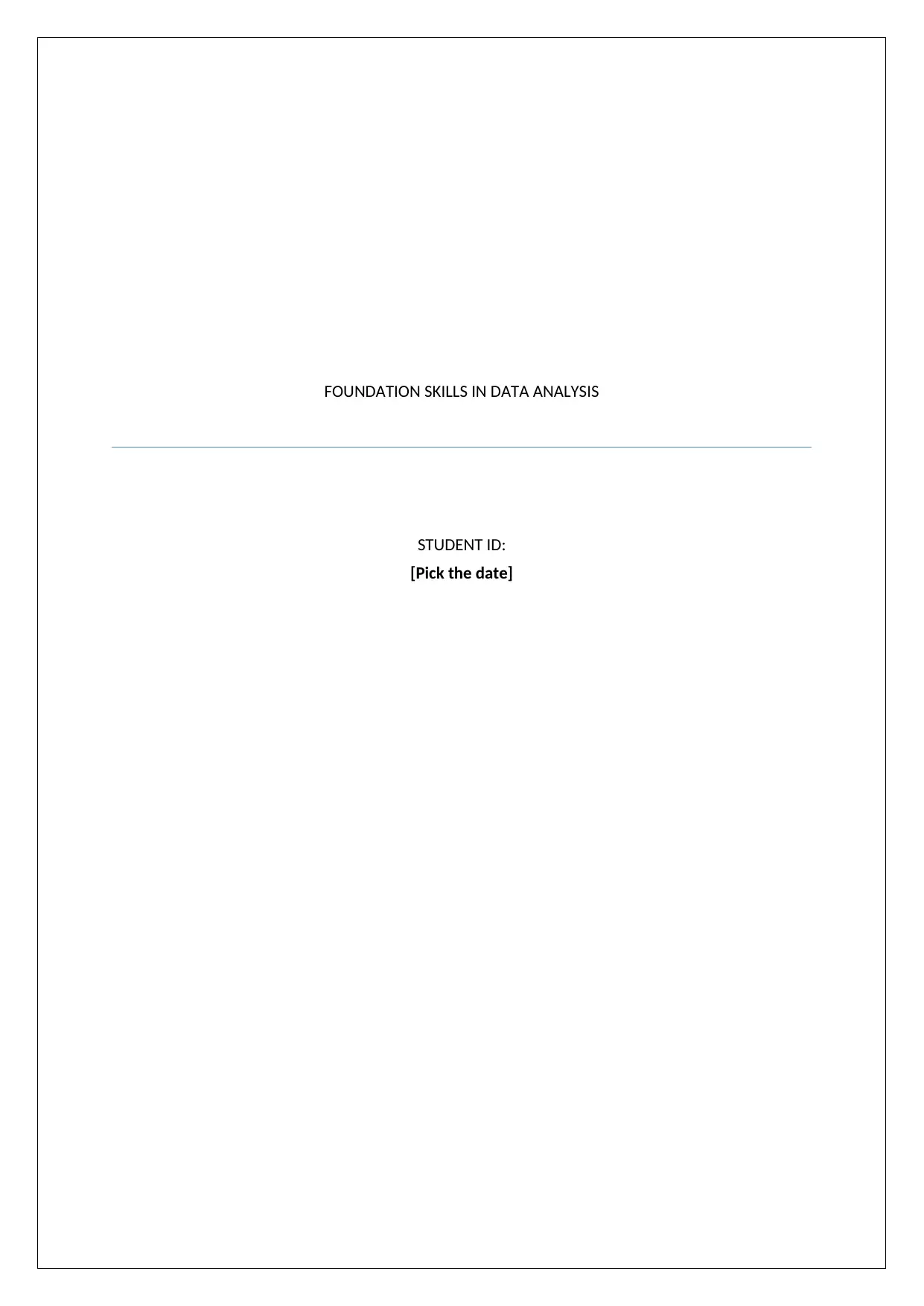
FOUNDATION SKILLS IN DATA ANALYSIS
STUDENT ID:
[Pick the date]
STUDENT ID:
[Pick the date]
Paraphrase This Document
Need a fresh take? Get an instant paraphrase of this document with our AI Paraphraser
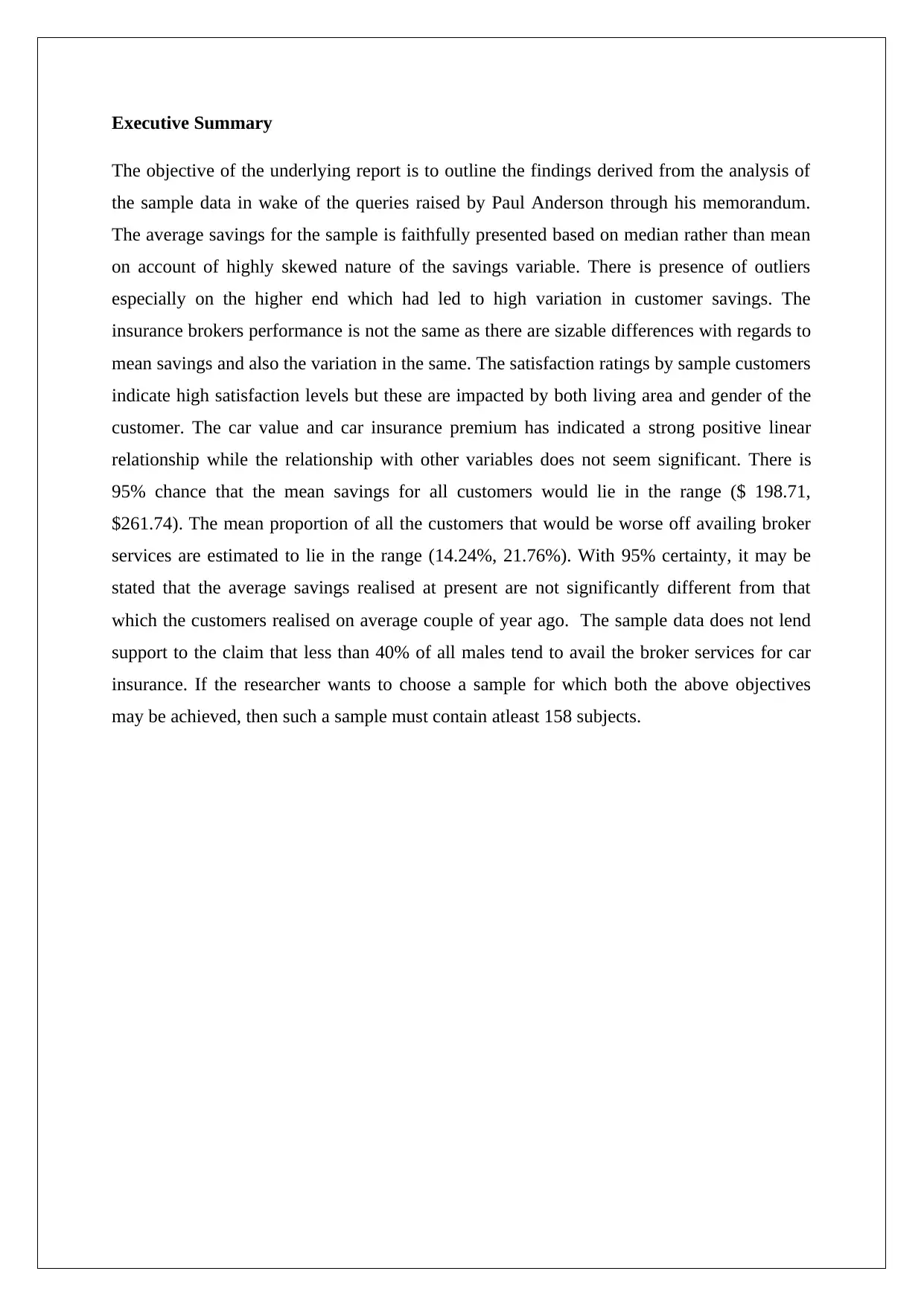
Executive Summary
The objective of the underlying report is to outline the findings derived from the analysis of
the sample data in wake of the queries raised by Paul Anderson through his memorandum.
The average savings for the sample is faithfully presented based on median rather than mean
on account of highly skewed nature of the savings variable. There is presence of outliers
especially on the higher end which had led to high variation in customer savings. The
insurance brokers performance is not the same as there are sizable differences with regards to
mean savings and also the variation in the same. The satisfaction ratings by sample customers
indicate high satisfaction levels but these are impacted by both living area and gender of the
customer. The car value and car insurance premium has indicated a strong positive linear
relationship while the relationship with other variables does not seem significant. There is
95% chance that the mean savings for all customers would lie in the range ($ 198.71,
$261.74). The mean proportion of all the customers that would be worse off availing broker
services are estimated to lie in the range (14.24%, 21.76%). With 95% certainty, it may be
stated that the average savings realised at present are not significantly different from that
which the customers realised on average couple of year ago. The sample data does not lend
support to the claim that less than 40% of all males tend to avail the broker services for car
insurance. If the researcher wants to choose a sample for which both the above objectives
may be achieved, then such a sample must contain atleast 158 subjects.
The objective of the underlying report is to outline the findings derived from the analysis of
the sample data in wake of the queries raised by Paul Anderson through his memorandum.
The average savings for the sample is faithfully presented based on median rather than mean
on account of highly skewed nature of the savings variable. There is presence of outliers
especially on the higher end which had led to high variation in customer savings. The
insurance brokers performance is not the same as there are sizable differences with regards to
mean savings and also the variation in the same. The satisfaction ratings by sample customers
indicate high satisfaction levels but these are impacted by both living area and gender of the
customer. The car value and car insurance premium has indicated a strong positive linear
relationship while the relationship with other variables does not seem significant. There is
95% chance that the mean savings for all customers would lie in the range ($ 198.71,
$261.74). The mean proportion of all the customers that would be worse off availing broker
services are estimated to lie in the range (14.24%, 21.76%). With 95% certainty, it may be
stated that the average savings realised at present are not significantly different from that
which the customers realised on average couple of year ago. The sample data does not lend
support to the claim that less than 40% of all males tend to avail the broker services for car
insurance. If the researcher wants to choose a sample for which both the above objectives
may be achieved, then such a sample must contain atleast 158 subjects.
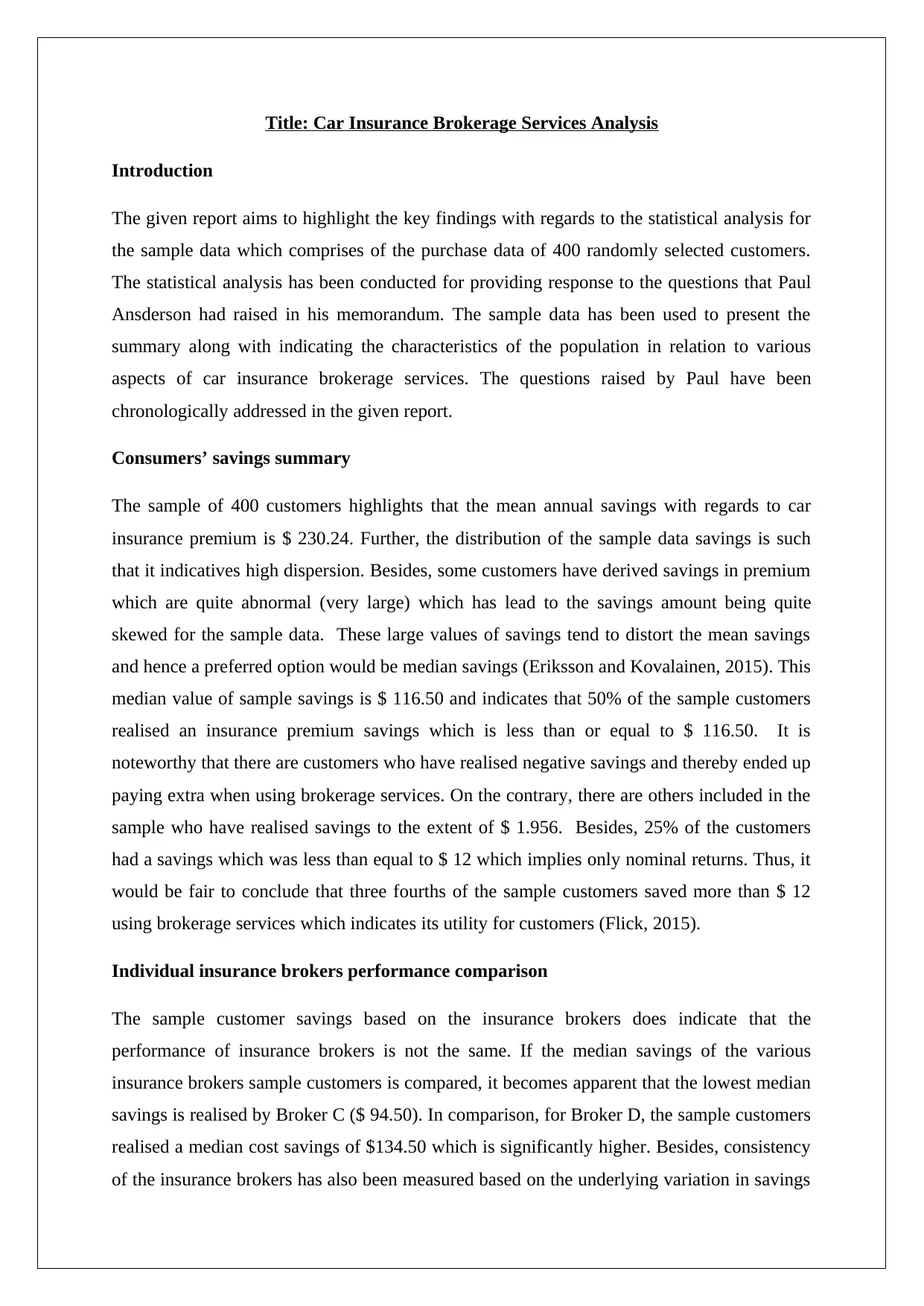
Title: Car Insurance Brokerage Services Analysis
Introduction
The given report aims to highlight the key findings with regards to the statistical analysis for
the sample data which comprises of the purchase data of 400 randomly selected customers.
The statistical analysis has been conducted for providing response to the questions that Paul
Ansderson had raised in his memorandum. The sample data has been used to present the
summary along with indicating the characteristics of the population in relation to various
aspects of car insurance brokerage services. The questions raised by Paul have been
chronologically addressed in the given report.
Consumers’ savings summary
The sample of 400 customers highlights that the mean annual savings with regards to car
insurance premium is $ 230.24. Further, the distribution of the sample data savings is such
that it indicatives high dispersion. Besides, some customers have derived savings in premium
which are quite abnormal (very large) which has lead to the savings amount being quite
skewed for the sample data. These large values of savings tend to distort the mean savings
and hence a preferred option would be median savings (Eriksson and Kovalainen, 2015). This
median value of sample savings is $ 116.50 and indicates that 50% of the sample customers
realised an insurance premium savings which is less than or equal to $ 116.50. It is
noteworthy that there are customers who have realised negative savings and thereby ended up
paying extra when using brokerage services. On the contrary, there are others included in the
sample who have realised savings to the extent of $ 1.956. Besides, 25% of the customers
had a savings which was less than equal to $ 12 which implies only nominal returns. Thus, it
would be fair to conclude that three fourths of the sample customers saved more than $ 12
using brokerage services which indicates its utility for customers (Flick, 2015).
Individual insurance brokers performance comparison
The sample customer savings based on the insurance brokers does indicate that the
performance of insurance brokers is not the same. If the median savings of the various
insurance brokers sample customers is compared, it becomes apparent that the lowest median
savings is realised by Broker C ($ 94.50). In comparison, for Broker D, the sample customers
realised a median cost savings of $134.50 which is significantly higher. Besides, consistency
of the insurance brokers has also been measured based on the underlying variation in savings
Introduction
The given report aims to highlight the key findings with regards to the statistical analysis for
the sample data which comprises of the purchase data of 400 randomly selected customers.
The statistical analysis has been conducted for providing response to the questions that Paul
Ansderson had raised in his memorandum. The sample data has been used to present the
summary along with indicating the characteristics of the population in relation to various
aspects of car insurance brokerage services. The questions raised by Paul have been
chronologically addressed in the given report.
Consumers’ savings summary
The sample of 400 customers highlights that the mean annual savings with regards to car
insurance premium is $ 230.24. Further, the distribution of the sample data savings is such
that it indicatives high dispersion. Besides, some customers have derived savings in premium
which are quite abnormal (very large) which has lead to the savings amount being quite
skewed for the sample data. These large values of savings tend to distort the mean savings
and hence a preferred option would be median savings (Eriksson and Kovalainen, 2015). This
median value of sample savings is $ 116.50 and indicates that 50% of the sample customers
realised an insurance premium savings which is less than or equal to $ 116.50. It is
noteworthy that there are customers who have realised negative savings and thereby ended up
paying extra when using brokerage services. On the contrary, there are others included in the
sample who have realised savings to the extent of $ 1.956. Besides, 25% of the customers
had a savings which was less than equal to $ 12 which implies only nominal returns. Thus, it
would be fair to conclude that three fourths of the sample customers saved more than $ 12
using brokerage services which indicates its utility for customers (Flick, 2015).
Individual insurance brokers performance comparison
The sample customer savings based on the insurance brokers does indicate that the
performance of insurance brokers is not the same. If the median savings of the various
insurance brokers sample customers is compared, it becomes apparent that the lowest median
savings is realised by Broker C ($ 94.50). In comparison, for Broker D, the sample customers
realised a median cost savings of $134.50 which is significantly higher. Besides, consistency
of the insurance brokers has also been measured based on the underlying variation in savings
⊘ This is a preview!⊘
Do you want full access?
Subscribe today to unlock all pages.

Trusted by 1+ million students worldwide
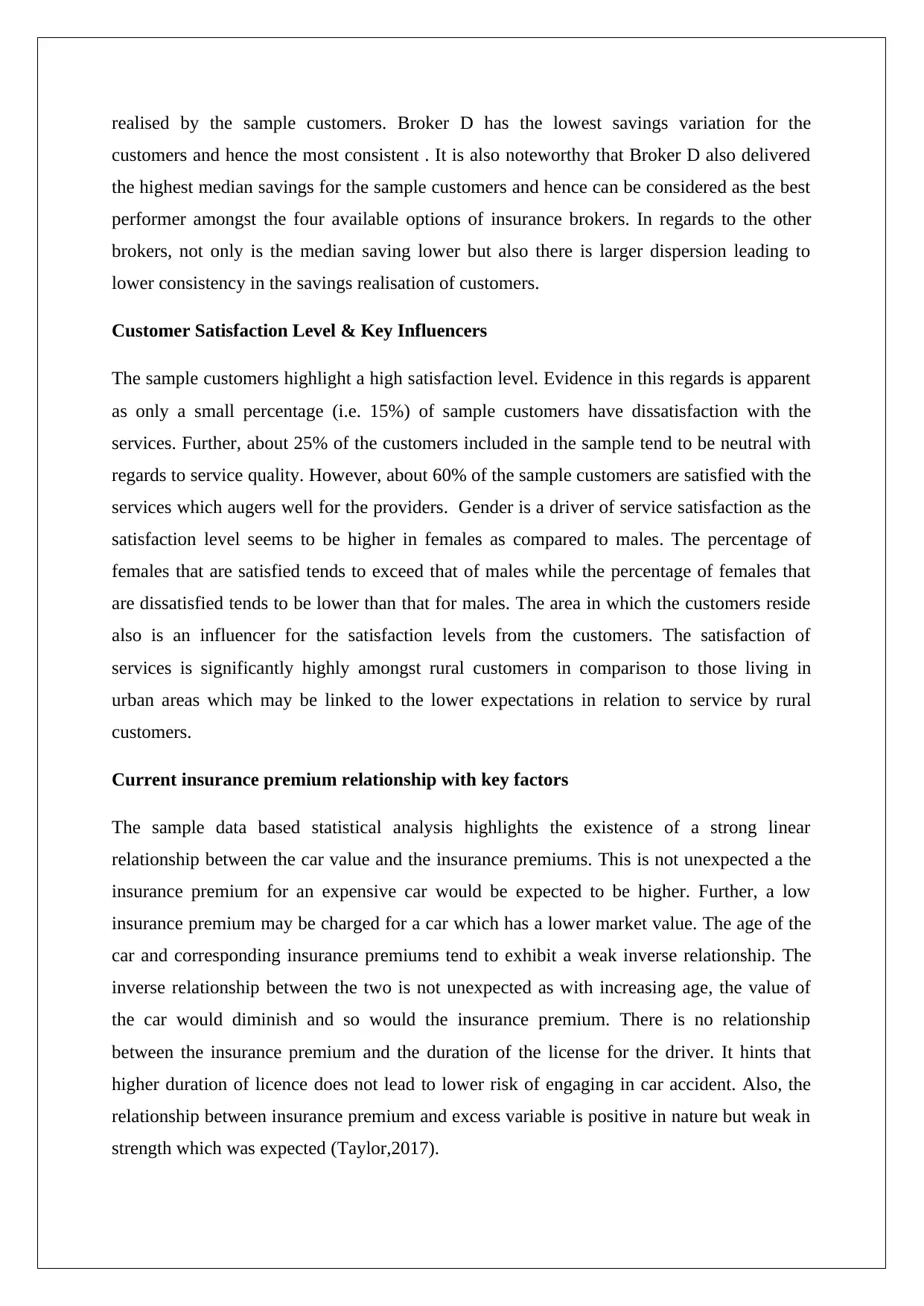
realised by the sample customers. Broker D has the lowest savings variation for the
customers and hence the most consistent . It is also noteworthy that Broker D also delivered
the highest median savings for the sample customers and hence can be considered as the best
performer amongst the four available options of insurance brokers. In regards to the other
brokers, not only is the median saving lower but also there is larger dispersion leading to
lower consistency in the savings realisation of customers.
Customer Satisfaction Level & Key Influencers
The sample customers highlight a high satisfaction level. Evidence in this regards is apparent
as only a small percentage (i.e. 15%) of sample customers have dissatisfaction with the
services. Further, about 25% of the customers included in the sample tend to be neutral with
regards to service quality. However, about 60% of the sample customers are satisfied with the
services which augers well for the providers. Gender is a driver of service satisfaction as the
satisfaction level seems to be higher in females as compared to males. The percentage of
females that are satisfied tends to exceed that of males while the percentage of females that
are dissatisfied tends to be lower than that for males. The area in which the customers reside
also is an influencer for the satisfaction levels from the customers. The satisfaction of
services is significantly highly amongst rural customers in comparison to those living in
urban areas which may be linked to the lower expectations in relation to service by rural
customers.
Current insurance premium relationship with key factors
The sample data based statistical analysis highlights the existence of a strong linear
relationship between the car value and the insurance premiums. This is not unexpected a the
insurance premium for an expensive car would be expected to be higher. Further, a low
insurance premium may be charged for a car which has a lower market value. The age of the
car and corresponding insurance premiums tend to exhibit a weak inverse relationship. The
inverse relationship between the two is not unexpected as with increasing age, the value of
the car would diminish and so would the insurance premium. There is no relationship
between the insurance premium and the duration of the license for the driver. It hints that
higher duration of licence does not lead to lower risk of engaging in car accident. Also, the
relationship between insurance premium and excess variable is positive in nature but weak in
strength which was expected (Taylor,2017).
customers and hence the most consistent . It is also noteworthy that Broker D also delivered
the highest median savings for the sample customers and hence can be considered as the best
performer amongst the four available options of insurance brokers. In regards to the other
brokers, not only is the median saving lower but also there is larger dispersion leading to
lower consistency in the savings realisation of customers.
Customer Satisfaction Level & Key Influencers
The sample customers highlight a high satisfaction level. Evidence in this regards is apparent
as only a small percentage (i.e. 15%) of sample customers have dissatisfaction with the
services. Further, about 25% of the customers included in the sample tend to be neutral with
regards to service quality. However, about 60% of the sample customers are satisfied with the
services which augers well for the providers. Gender is a driver of service satisfaction as the
satisfaction level seems to be higher in females as compared to males. The percentage of
females that are satisfied tends to exceed that of males while the percentage of females that
are dissatisfied tends to be lower than that for males. The area in which the customers reside
also is an influencer for the satisfaction levels from the customers. The satisfaction of
services is significantly highly amongst rural customers in comparison to those living in
urban areas which may be linked to the lower expectations in relation to service by rural
customers.
Current insurance premium relationship with key factors
The sample data based statistical analysis highlights the existence of a strong linear
relationship between the car value and the insurance premiums. This is not unexpected a the
insurance premium for an expensive car would be expected to be higher. Further, a low
insurance premium may be charged for a car which has a lower market value. The age of the
car and corresponding insurance premiums tend to exhibit a weak inverse relationship. The
inverse relationship between the two is not unexpected as with increasing age, the value of
the car would diminish and so would the insurance premium. There is no relationship
between the insurance premium and the duration of the license for the driver. It hints that
higher duration of licence does not lead to lower risk of engaging in car accident. Also, the
relationship between insurance premium and excess variable is positive in nature but weak in
strength which was expected (Taylor,2017).
Paraphrase This Document
Need a fresh take? Get an instant paraphrase of this document with our AI Paraphraser
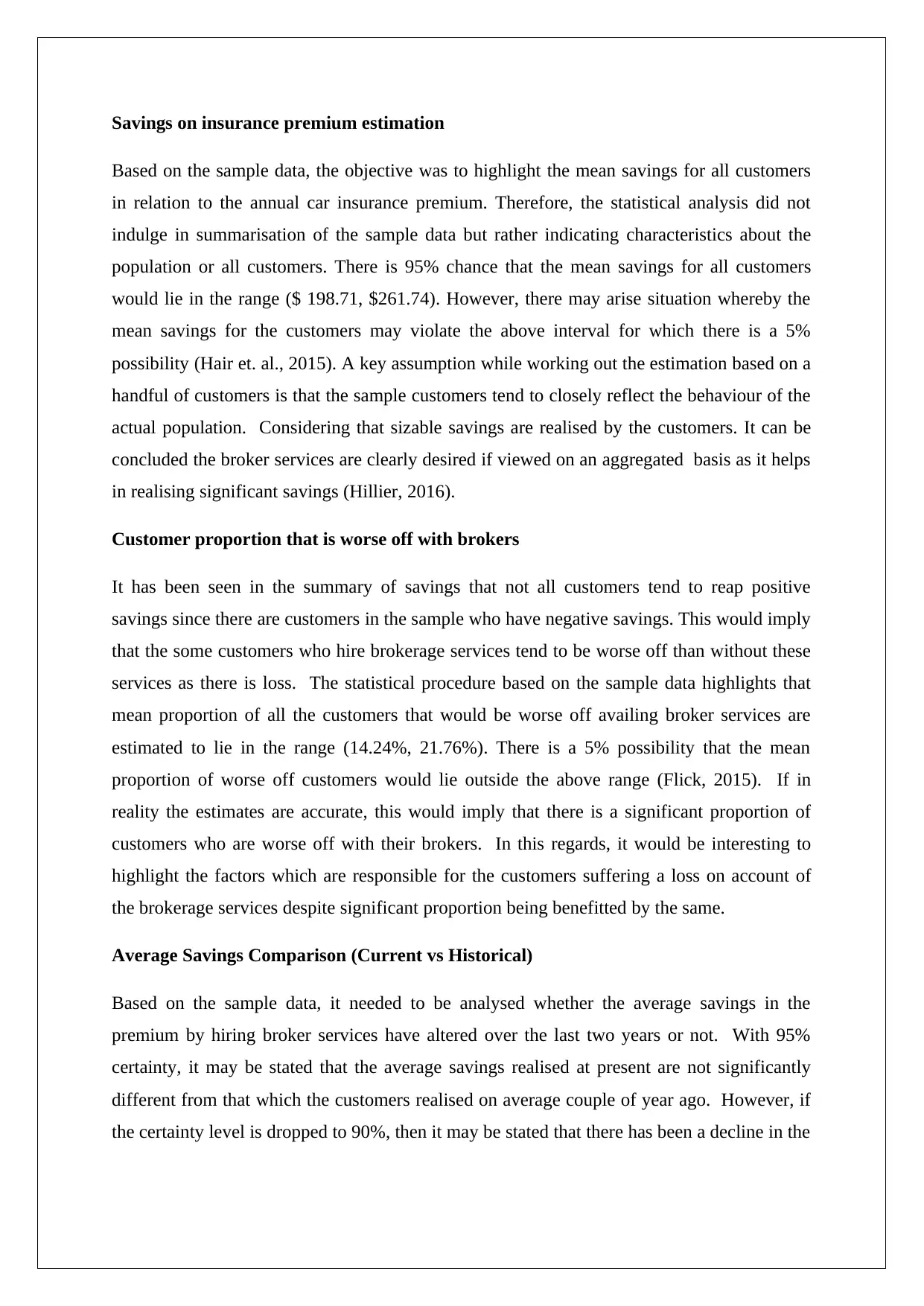
Savings on insurance premium estimation
Based on the sample data, the objective was to highlight the mean savings for all customers
in relation to the annual car insurance premium. Therefore, the statistical analysis did not
indulge in summarisation of the sample data but rather indicating characteristics about the
population or all customers. There is 95% chance that the mean savings for all customers
would lie in the range ($ 198.71, $261.74). However, there may arise situation whereby the
mean savings for the customers may violate the above interval for which there is a 5%
possibility (Hair et. al., 2015). A key assumption while working out the estimation based on a
handful of customers is that the sample customers tend to closely reflect the behaviour of the
actual population. Considering that sizable savings are realised by the customers. It can be
concluded the broker services are clearly desired if viewed on an aggregated basis as it helps
in realising significant savings (Hillier, 2016).
Customer proportion that is worse off with brokers
It has been seen in the summary of savings that not all customers tend to reap positive
savings since there are customers in the sample who have negative savings. This would imply
that the some customers who hire brokerage services tend to be worse off than without these
services as there is loss. The statistical procedure based on the sample data highlights that
mean proportion of all the customers that would be worse off availing broker services are
estimated to lie in the range (14.24%, 21.76%). There is a 5% possibility that the mean
proportion of worse off customers would lie outside the above range (Flick, 2015). If in
reality the estimates are accurate, this would imply that there is a significant proportion of
customers who are worse off with their brokers. In this regards, it would be interesting to
highlight the factors which are responsible for the customers suffering a loss on account of
the brokerage services despite significant proportion being benefitted by the same.
Average Savings Comparison (Current vs Historical)
Based on the sample data, it needed to be analysed whether the average savings in the
premium by hiring broker services have altered over the last two years or not. With 95%
certainty, it may be stated that the average savings realised at present are not significantly
different from that which the customers realised on average couple of year ago. However, if
the certainty level is dropped to 90%, then it may be stated that there has been a decline in the
Based on the sample data, the objective was to highlight the mean savings for all customers
in relation to the annual car insurance premium. Therefore, the statistical analysis did not
indulge in summarisation of the sample data but rather indicating characteristics about the
population or all customers. There is 95% chance that the mean savings for all customers
would lie in the range ($ 198.71, $261.74). However, there may arise situation whereby the
mean savings for the customers may violate the above interval for which there is a 5%
possibility (Hair et. al., 2015). A key assumption while working out the estimation based on a
handful of customers is that the sample customers tend to closely reflect the behaviour of the
actual population. Considering that sizable savings are realised by the customers. It can be
concluded the broker services are clearly desired if viewed on an aggregated basis as it helps
in realising significant savings (Hillier, 2016).
Customer proportion that is worse off with brokers
It has been seen in the summary of savings that not all customers tend to reap positive
savings since there are customers in the sample who have negative savings. This would imply
that the some customers who hire brokerage services tend to be worse off than without these
services as there is loss. The statistical procedure based on the sample data highlights that
mean proportion of all the customers that would be worse off availing broker services are
estimated to lie in the range (14.24%, 21.76%). There is a 5% possibility that the mean
proportion of worse off customers would lie outside the above range (Flick, 2015). If in
reality the estimates are accurate, this would imply that there is a significant proportion of
customers who are worse off with their brokers. In this regards, it would be interesting to
highlight the factors which are responsible for the customers suffering a loss on account of
the brokerage services despite significant proportion being benefitted by the same.
Average Savings Comparison (Current vs Historical)
Based on the sample data, it needed to be analysed whether the average savings in the
premium by hiring broker services have altered over the last two years or not. With 95%
certainty, it may be stated that the average savings realised at present are not significantly
different from that which the customers realised on average couple of year ago. However, if
the certainty level is dropped to 90%, then it may be stated that there has been a decline in the
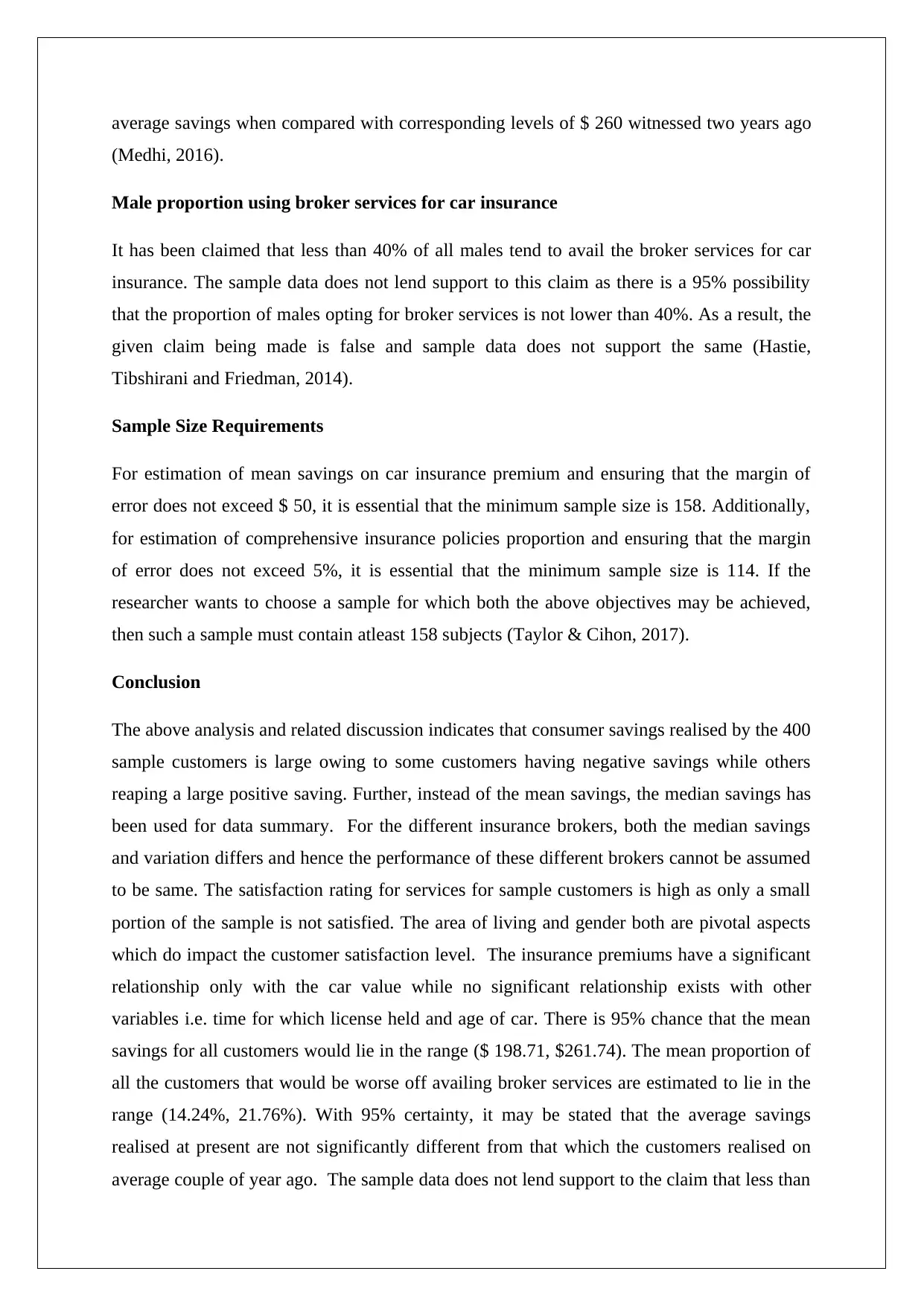
average savings when compared with corresponding levels of $ 260 witnessed two years ago
(Medhi, 2016).
Male proportion using broker services for car insurance
It has been claimed that less than 40% of all males tend to avail the broker services for car
insurance. The sample data does not lend support to this claim as there is a 95% possibility
that the proportion of males opting for broker services is not lower than 40%. As a result, the
given claim being made is false and sample data does not support the same (Hastie,
Tibshirani and Friedman, 2014).
Sample Size Requirements
For estimation of mean savings on car insurance premium and ensuring that the margin of
error does not exceed $ 50, it is essential that the minimum sample size is 158. Additionally,
for estimation of comprehensive insurance policies proportion and ensuring that the margin
of error does not exceed 5%, it is essential that the minimum sample size is 114. If the
researcher wants to choose a sample for which both the above objectives may be achieved,
then such a sample must contain atleast 158 subjects (Taylor & Cihon, 2017).
Conclusion
The above analysis and related discussion indicates that consumer savings realised by the 400
sample customers is large owing to some customers having negative savings while others
reaping a large positive saving. Further, instead of the mean savings, the median savings has
been used for data summary. For the different insurance brokers, both the median savings
and variation differs and hence the performance of these different brokers cannot be assumed
to be same. The satisfaction rating for services for sample customers is high as only a small
portion of the sample is not satisfied. The area of living and gender both are pivotal aspects
which do impact the customer satisfaction level. The insurance premiums have a significant
relationship only with the car value while no significant relationship exists with other
variables i.e. time for which license held and age of car. There is 95% chance that the mean
savings for all customers would lie in the range ($ 198.71, $261.74). The mean proportion of
all the customers that would be worse off availing broker services are estimated to lie in the
range (14.24%, 21.76%). With 95% certainty, it may be stated that the average savings
realised at present are not significantly different from that which the customers realised on
average couple of year ago. The sample data does not lend support to the claim that less than
(Medhi, 2016).
Male proportion using broker services for car insurance
It has been claimed that less than 40% of all males tend to avail the broker services for car
insurance. The sample data does not lend support to this claim as there is a 95% possibility
that the proportion of males opting for broker services is not lower than 40%. As a result, the
given claim being made is false and sample data does not support the same (Hastie,
Tibshirani and Friedman, 2014).
Sample Size Requirements
For estimation of mean savings on car insurance premium and ensuring that the margin of
error does not exceed $ 50, it is essential that the minimum sample size is 158. Additionally,
for estimation of comprehensive insurance policies proportion and ensuring that the margin
of error does not exceed 5%, it is essential that the minimum sample size is 114. If the
researcher wants to choose a sample for which both the above objectives may be achieved,
then such a sample must contain atleast 158 subjects (Taylor & Cihon, 2017).
Conclusion
The above analysis and related discussion indicates that consumer savings realised by the 400
sample customers is large owing to some customers having negative savings while others
reaping a large positive saving. Further, instead of the mean savings, the median savings has
been used for data summary. For the different insurance brokers, both the median savings
and variation differs and hence the performance of these different brokers cannot be assumed
to be same. The satisfaction rating for services for sample customers is high as only a small
portion of the sample is not satisfied. The area of living and gender both are pivotal aspects
which do impact the customer satisfaction level. The insurance premiums have a significant
relationship only with the car value while no significant relationship exists with other
variables i.e. time for which license held and age of car. There is 95% chance that the mean
savings for all customers would lie in the range ($ 198.71, $261.74). The mean proportion of
all the customers that would be worse off availing broker services are estimated to lie in the
range (14.24%, 21.76%). With 95% certainty, it may be stated that the average savings
realised at present are not significantly different from that which the customers realised on
average couple of year ago. The sample data does not lend support to the claim that less than
⊘ This is a preview!⊘
Do you want full access?
Subscribe today to unlock all pages.

Trusted by 1+ million students worldwide
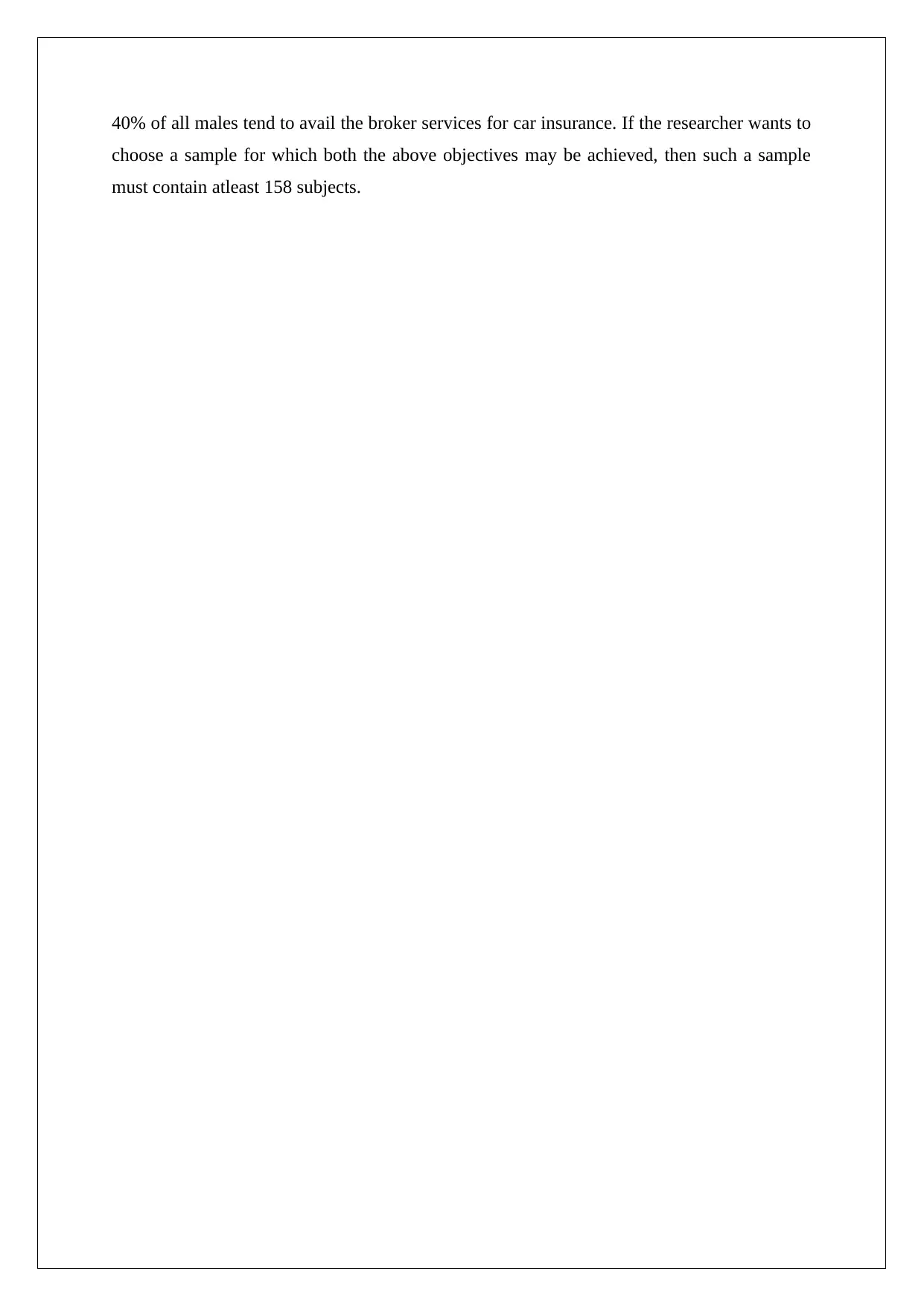
40% of all males tend to avail the broker services for car insurance. If the researcher wants to
choose a sample for which both the above objectives may be achieved, then such a sample
must contain atleast 158 subjects.
choose a sample for which both the above objectives may be achieved, then such a sample
must contain atleast 158 subjects.
Paraphrase This Document
Need a fresh take? Get an instant paraphrase of this document with our AI Paraphraser
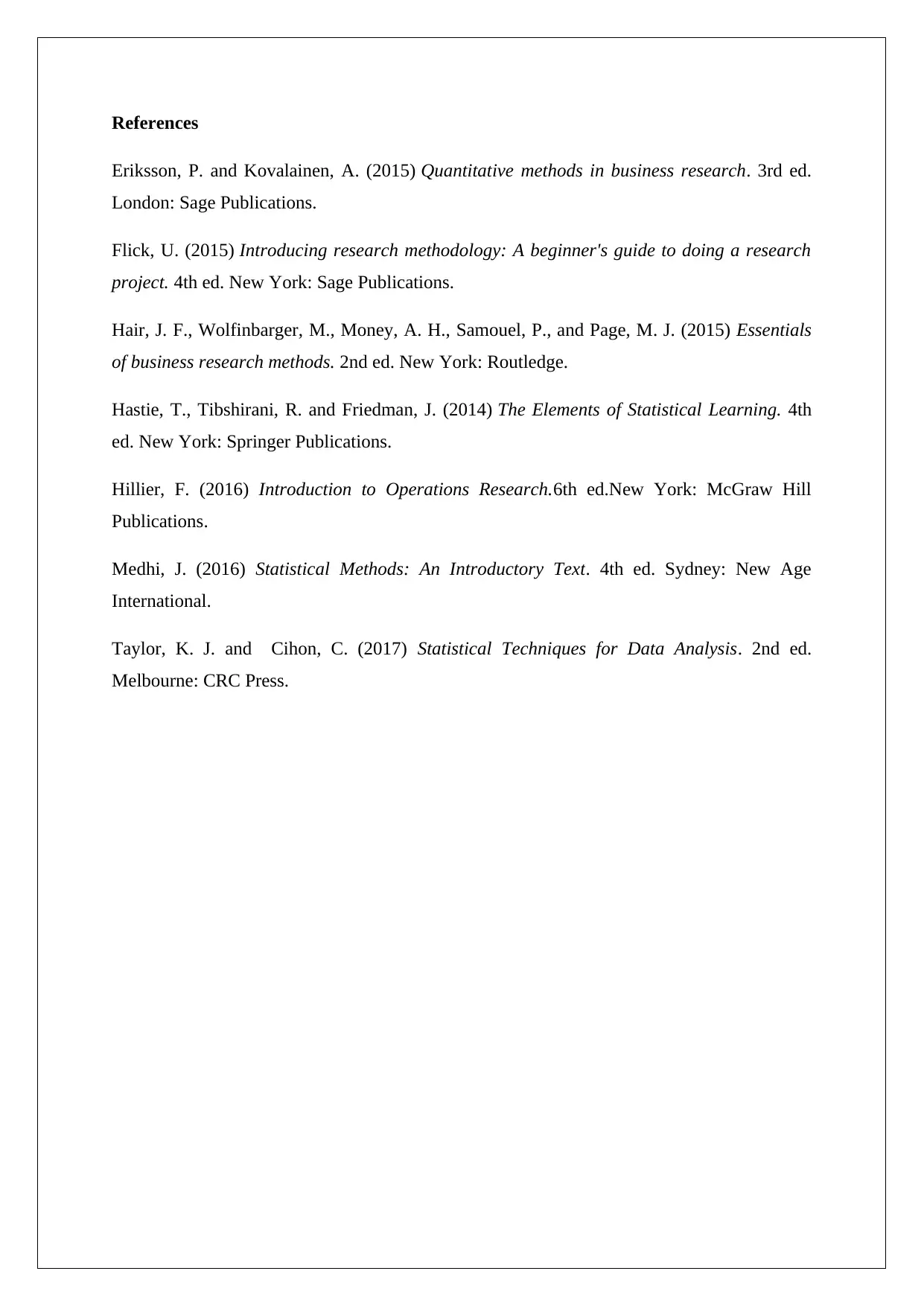
References
Eriksson, P. and Kovalainen, A. (2015) Quantitative methods in business research. 3rd ed.
London: Sage Publications.
Flick, U. (2015) Introducing research methodology: A beginner's guide to doing a research
project. 4th ed. New York: Sage Publications.
Hair, J. F., Wolfinbarger, M., Money, A. H., Samouel, P., and Page, M. J. (2015) Essentials
of business research methods. 2nd ed. New York: Routledge.
Hastie, T., Tibshirani, R. and Friedman, J. (2014) The Elements of Statistical Learning. 4th
ed. New York: Springer Publications.
Hillier, F. (2016) Introduction to Operations Research.6th ed.New York: McGraw Hill
Publications.
Medhi, J. (2016) Statistical Methods: An Introductory Text. 4th ed. Sydney: New Age
International.
Taylor, K. J. and Cihon, C. (2017) Statistical Techniques for Data Analysis. 2nd ed.
Melbourne: CRC Press.
Eriksson, P. and Kovalainen, A. (2015) Quantitative methods in business research. 3rd ed.
London: Sage Publications.
Flick, U. (2015) Introducing research methodology: A beginner's guide to doing a research
project. 4th ed. New York: Sage Publications.
Hair, J. F., Wolfinbarger, M., Money, A. H., Samouel, P., and Page, M. J. (2015) Essentials
of business research methods. 2nd ed. New York: Routledge.
Hastie, T., Tibshirani, R. and Friedman, J. (2014) The Elements of Statistical Learning. 4th
ed. New York: Springer Publications.
Hillier, F. (2016) Introduction to Operations Research.6th ed.New York: McGraw Hill
Publications.
Medhi, J. (2016) Statistical Methods: An Introductory Text. 4th ed. Sydney: New Age
International.
Taylor, K. J. and Cihon, C. (2017) Statistical Techniques for Data Analysis. 2nd ed.
Melbourne: CRC Press.
1 out of 8
Related Documents
Your All-in-One AI-Powered Toolkit for Academic Success.
+13062052269
info@desklib.com
Available 24*7 on WhatsApp / Email
![[object Object]](/_next/static/media/star-bottom.7253800d.svg)
Unlock your academic potential
Copyright © 2020–2025 A2Z Services. All Rights Reserved. Developed and managed by ZUCOL.





